For the previous article in this series please see:
“The 2022 Drought in Cornwall“
As Cornwall’s reservoirs finally begin refilling after a long hot summer South West Water announced in a press release last week that:
As part of South West Water’s continued investment in water resilience across the region, the company is today applying for a permit to unlock supplies from a new source in Cornwall.
Hawks Tor was a redundant china clay pit on Bodmin Moor purchased by South West Water in March 2022, the brownfield site has been converted into a water source and should be supplying customers this month.
This will be the first reservoir brought online by any water company in the country during the ongoing drought, using the latest technology to secure supplies in the short term and provide greater longer term resilience.
Susan Davy, CEO of Pennon Group which owns South West Water, said: “We continue to deliver on our long-standing commitment to investing in our region’s water resources, building capacity where it is needed most and ensuring long-term water resilience across the region. Having only acquired the site a matter of months ago, Hawks Tor should be supplying customers in November. We Continue to take early and proactive actions to ensure the security of water supply for our region during the current drought and into the future.”
The company is investing in new reservoirs and finding innovative ways to collect, store and treat water. This includes Stannon Lake, Porth Reservoir and the most recent acquisition, Hawks Tor. These additional resources will provide up to 30% of Cornwall’s water requirement in the future. This is alongside investment of £27 million in the region’s water grid, ensuring water can be moved to where it’s most needed.
South West Water has today formally applied for a drought permit for Hawks Tor which will allow it to immediately increase water supply to the public and refill Colliford Reservoir through the abstraction of up to 8 million litres of water per day. The permit will also reduce the risk of further restrictions being required in Spring/Summer 2023.
As river and reservoir levels remain low across the region following one of the hottest and driest periods in 130 years, South West Water has also been actively working with customers and businesses to help them save both water and money. The company’s Stop the Drop campaign is encouraging everyone to continue to do their bit to collectively reduce demand to avoid further restrictions and protect reservoir levels as the current drought in the region continues.
South West Water’s application for a drought permit to abstract water from Hawks Tor Reservoir makes sobering reading. Here is an extract:
This analysis has found that rainfall over the assessed period (November 2021 to September 2022) is considered to constitute an Exceptional Shortage of Rain.
Ranked cumulative rainfall shows the period of analysis to be the fifth driest in a record starting in 1891 and ranked higher than several known drought events across the UK.

Under average year assumptions a storage level of 80% is considered required to avoid Drought Level 1 in the following year.
The projection without intervention for Colliford Reservoir has deteriorated. Figure 4 illustrates that a 100% long term average (“LTA”) rainfall scenario the reservoir recovers to 35%, and a 60% LTA rainfall scenario recovers to 15% LTA. Given the ESOR throughout 2022, Colliford Reservoir therefore requires additional winter storage to recover to target of 80% by 1 April 2023, even with the wettest previously experienced winter conditions.
Colliford Reservoir is part of a conjunctive system and has a net capacity of 65% of the total storage for Colliford Water Resource Zone. Reservoir levels across the entire Colliford WRZ are depleted, total storage within the WRZ is currently 21.1% on 28 October 2022. Table 3 below sets out the current reservoir levels of all reservoirs across Colliford WRZ.
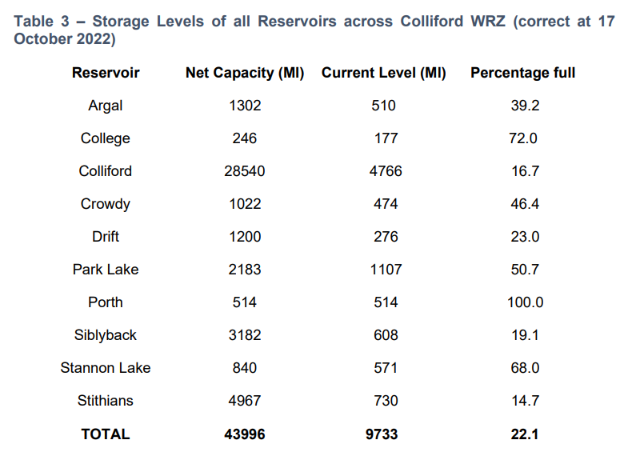
[Edit – November 10th]The consequence of the exceptional shortage of rainfall experienced from November 2021 and throughout 2022 has resulted in Colliford Reservoir storage falling to a record low level since impoundment in 1984. Colliford Reservoir is presently (as of 28 October 2022) at 14.9% and crossed Drought Level 2 on 30 September 2022. The immediate risk is escalating, under all circumstances the risk for next summer is significant, necessitating action to prepare for 2023.
This drawdown has been driven by the exceptional shortage of rainfall observed since November 2021. Last year’s winter recharge season was lower than average meaning that we started the draw-down period at 80% full. Rainfall has continued to be exceptionally low since April 2022 affording no further recharge.
During 2022, the exceptional shortage of rainfall reduced inflow into Colliford Reservoir to 5081Ml compared to 8518Ml in 2021. South West Water has also released significantly more water for augmentation in 2022 to maintain river flows, 13064Ml compared to 8518Ml in 2021.
In total this volumetric difference contributed to the equivalent of a 31% fall in storage at Colliford Reservoir…
We have examined the range of winter weather scenarios and believe that relying solely upon the natural recharge for Colliford Reservoir is likely to present a risk to supply in 2023.
In conclusion it has been so dry over 2022 that under all foreseeable circumstances natural refill to suitable operational levels, in Colliford Reservoir, for 2023 is unlikely, and therefore represents the need to explore all options to increase storage. The additional water from Hawks Tor Pit will help us to achieve this.
South West Water’s latest water level data reveals that on November 6th Colliford Lake had risen to 17.1% of total net capacity, a weekly increase of 1.8%:
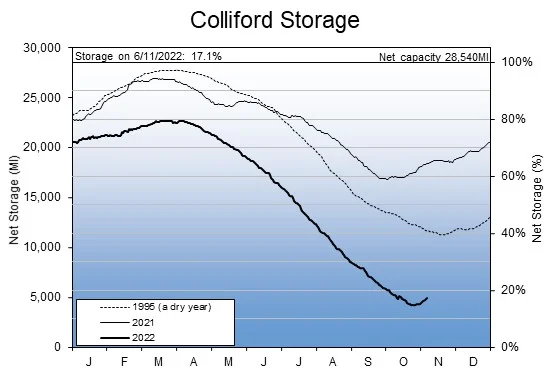
Stithians Reservoir is now at 16.3% of total capacity, an increase of 2.3% over the week:
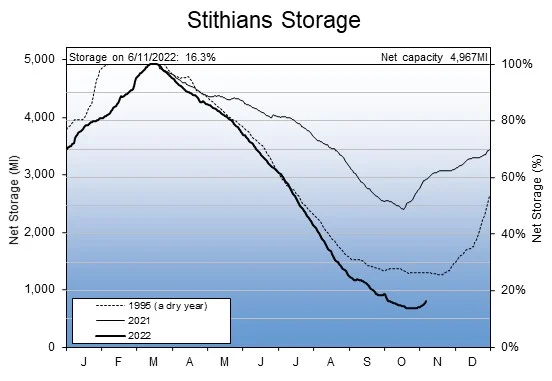
Another rainy week’s worth of water level data has now been published. Colliford Lake rose by 1.4% over the week to November 13th, to reach a total net capacity of 18.5%:

Stithians Reservoir has reached 17.9% of total capacity, an increase of 1.6% over the week:

The South West Lakes Trust has also published a table including water levels for the smaller reservoirs in Cornwall, updated to November 11th:

South West Water managed to achieve their aim of filling Colliford Lake to at least 30% of total net capacity by the end of 2022:
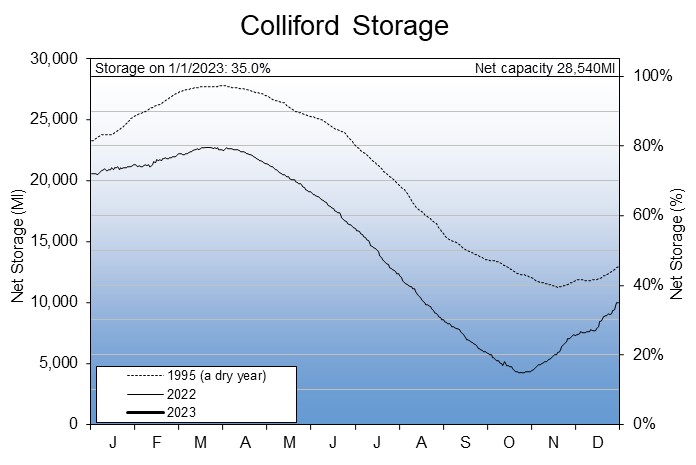
Here’s the latest data on other reservoirs in Cornwall:
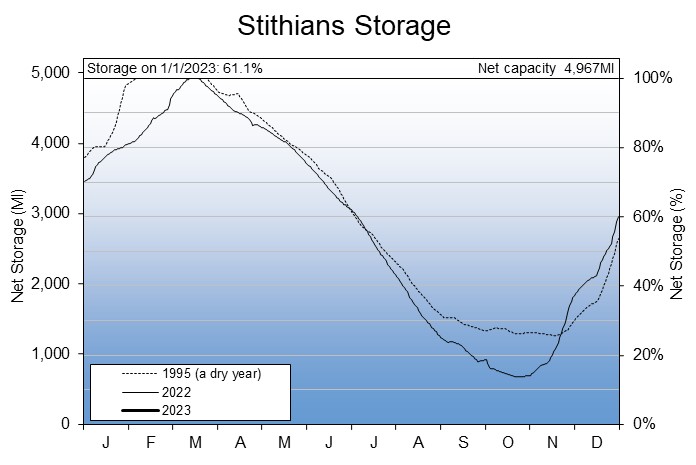
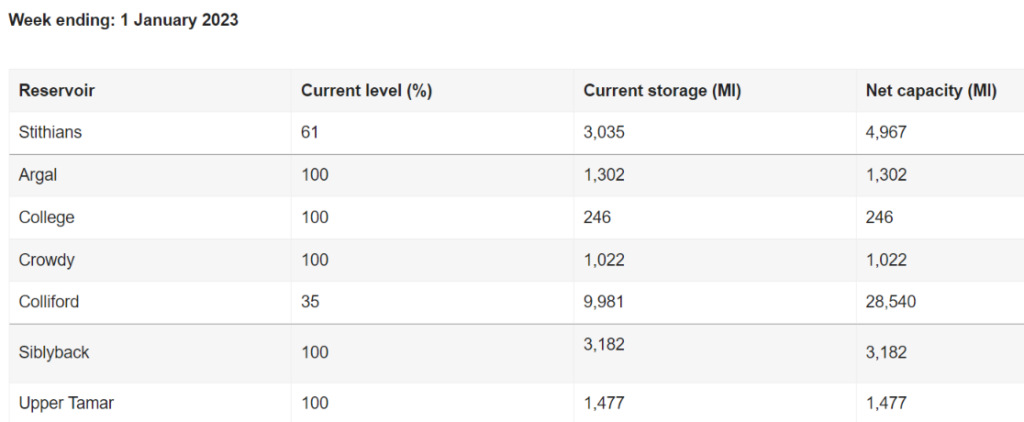
Our local Crowdy Reservoir is back up to 100%!
[Edit – January 21st]Here’s a pretty picture of a full to overflowing Crowdy Reservoir, on the horizon under the setting sun earlier today:

We have now started a series of articles on the topic of “Drought 2023”. The first can be viewed at:

In a press release today South West Water announced:
Obviously there has been a huge increase in demand from the 10s of thousands of additional housing built in the South West in recent years. With the boom in house building showing no signs of backing off. Southwest Water has a history of being behind the curve with capacity. Good to hear that some new capacity is coming on stream soon. I think jumping on the claim mate change bandwagon is not sufficient argument. It would make sense to show figures of increased demand from new housing and commercial premises and the projection of those thing in years to come given the huge number of large scale development being approved.
SWW’s demand projections leave much to be desired. This is from the “Insight into the 2022 drought” appendix to their draft Water Resource Management Plan for 2024-29:
They also “jump on the climate change bandwagon” on the supply side of the equation:
What about Devon?
What plans are in place to add another reservoir for helping Roadford Reservoir Area
What is the capacity of Hawks Tor reservoir?
The drought permit documents stated that:
However as far as I can tell they don’t specify a “usable capacity”.